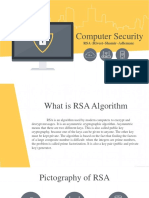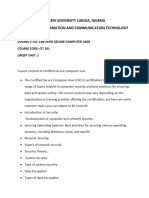0 ratings0% found this document useful (0 votes)
ch10 KeyManagement Diffie-Hellman ECC
ch10 KeyManagement Diffie-Hellman ECC
Uploaded by
Pranay Nandiwadekar1. The document discusses key management and the Diffie-Hellman key exchange protocol.
2. It describes different methods for distributing public keys including public announcement, directories, public key authorities, and certificates.
3. The document then explains how the Diffie-Hellman key exchange protocol works, how it allows two parties to securely establish a shared secret key over an insecure channel, and provides an example of how it can be implemented.
Copyright:
© All Rights Reserved
Available Formats
Download as PPT, PDF, TXT or read online from Scribd
Download as ppt, pdf, or txt
ch10 KeyManagement Diffie-Hellman ECC
ch10 KeyManagement Diffie-Hellman ECC
Uploaded by
Pranay Nandiwadekar0 ratings0% found this document useful (0 votes)
1. The document discusses key management and the Diffie-Hellman key exchange protocol.
2. It describes different methods for distributing public keys including public announcement, directories, public key authorities, and certificates.
3. The document then explains how the Diffie-Hellman key exchange protocol works, how it allows two parties to securely establish a shared secret key over an insecure channel, and provides an example of how it can be implemented.
Original Title
ch10.KeyManagement.Diffie-Hellman.ECC.ppt
Copyright
© © All Rights Reserved
Available Formats
PPT, PDF, TXT or read online from Scribd
Share this document
Did you find this document useful?
Is this content inappropriate?
1. The document discusses key management and the Diffie-Hellman key exchange protocol.
2. It describes different methods for distributing public keys including public announcement, directories, public key authorities, and certificates.
3. The document then explains how the Diffie-Hellman key exchange protocol works, how it allows two parties to securely establish a shared secret key over an insecure channel, and provides an example of how it can be implemented.
Copyright:
© All Rights Reserved
Available Formats
Download as PPT, PDF, TXT or read online from Scribd
Download as ppt, pdf, or txt
0 ratings0% found this document useful (0 votes)
ch10 KeyManagement Diffie-Hellman ECC
ch10 KeyManagement Diffie-Hellman ECC
Uploaded by
Pranay Nandiwadekar1. The document discusses key management and the Diffie-Hellman key exchange protocol.
2. It describes different methods for distributing public keys including public announcement, directories, public key authorities, and certificates.
3. The document then explains how the Diffie-Hellman key exchange protocol works, how it allows two parties to securely establish a shared secret key over an insecure channel, and provides an example of how it can be implemented.
Copyright:
© All Rights Reserved
Available Formats
Download as PPT, PDF, TXT or read online from Scribd
Download as ppt, pdf, or txt
You are on page 1/ 26
INCS 741: Cryptography
Key Management and Diffie-
Hellman
Dr. Monther Aldwairi
New York Institute of Technology-
Amman Campus
12/3/2009
12/3/2009 Dr. Monther Aldwairi 1
Key Management
• public-key encryption helps address key
distribution problems
• two aspects of this:
– distribution of public keys
– use of public-key encryption to distribute secret
keys
Distribution of Public Keys
• can be considered as using one of:
– public announcement
– publicly available directory
– public-key authority
– public-key certificates
Public Announcement
• users distribute public keys to recipients or
broadcast to community at large
– eg. append PGP keys to email messages or post to
news groups or email list
• major weakness is forgery
– anyone can create a key claiming to be someone
else and broadcast it
– until forgery is discovered can masquerade as
claimed user
Publicly Available Directory
• Registering keys with a public directory
– directory must be trusted entity or organization
– contains {name, public-key} entries
– is periodically published and accessed electronically
– participants register securely with directory
– participants can replace key at any time
• still vulnerable to tampering or forgery
– adversary succeeds in obtaining the private key of the
directory authority
– could tamper with the records kept by the authority.
Public-Key Authority
• improve security by tightening control over
distribution of keys from directory
• has properties of directory
• and requires users to know public key for the
directory
• then users interact with directory to obtain any
desired public key securely
– does require real-time access to directory when
keys are needed
Public-Key Authority
Public-Key Authority Drawbacks
• The public-key authority could be somewhat
of a bottleneck in the system
• A user must appeal to the authority for a public
key for every other user that it wishes to
contact.
• As before, the directory of names and public
keys maintained by the authority is vulnerable
to tampering.
11/8/2009 Dr. Monther Aldwairi 8
Public-Key Certificates
• certificates allow key exchange without real-
time access to public-key authority
• a certificate binds identity to public key
– usually with other info such as period of validity,
rights of use etc
• with all contents signed by a trusted Public-
Key or Certificate Authority (CA)
• can be verified by anyone who knows the
public-key certificate authorities public-key
Requirements
• Any participant determine the name and public
key of the certificate's owner.
• Any participant can verify that the certificate
originated from the certificate authority.
• Only the certificate authority can create and
update certificates.
• Any participant can verify the currency of the
certificate.
11/8/2009 Dr. Monther Aldwairi 10
Public-Key Certificates
Public-Key Distribution of Secret Keys
• use previous methods to obtain public-key
• can use for secrecy or authentication
• but public-key algorithms are slow
• so usually want to use private-key encryption
to protect message contents
• hence need a session key
• have several alternatives for negotiating a
suitable session
Simple Secret Key Distribution
• proposed by Merkle in 1979
– A generates a new temporary public key pair
– A sends B the public key and their identity
– B generates a session key K sends it to A encrypted using the
supplied public key
– A decrypts the session key and both use (discard keys)
• problem is that an opponent can intercept and
impersonate both halves of protocol
– adversary who can intercept messages and then either relay
the intercepted message or substitute another message
Man in the Middle Attack
• A generates a public/private key pair {PUa, PRa} and transmits a
message intended for B consisting of PUa and an identifier of A, IDA.
• E intercepts the message, creates its own public/private key pair
{PUe, PRe} and transmits PUe||IDA to B.
• B generates a secret key, Ks, and transmits E(PUe, Ks).
• E intercepts the message, and learns Ks by computing D(PRe, E(PUe,
Ks)).
• E transmits E(PUa, Ks) to A.
11/8/2009 Dr. Monther Aldwairi 14
Public-Key Distribution of Secret Keys
• if have securely exchanged public-keys:
Hybrid Key Distribution
• retain use of private-key KDC
• shares secret master key with each user
• distributes session key using master key
• public-key used to distribute master keys
– especially useful with widely distributed users
• rationale
– performance
– backward compatibility
Diffie-Hellman Key Exchange
• first public-key type scheme proposed
• by Diffie & Hellman in 1976 along with the
exposition of public key concepts
– note: now know that Williamson (UK CESG)
secretly proposed the concept in 1970
• is a practical method for public exchange of a
secret key
• used in a number of commercial products
Diffie-Hellman Key Exchange
• a public-key distribution scheme
– cannot be used to exchange an arbitrary message
– rather it can establish a common key
– known only to the two participants
• value of key depends on the participants (and their
private and public key information)
• based on exponentiation in a finite (Galois) field
(modulo a prime or a polynomial) - easy
• security relies on the difficulty of computing discrete
logarithms (similar to factoring) – hard
Discrete Logarithms
• a primitive root of a prime number p as one
whose powers modulo p generate all the integers
from 1 to p-1
– For any integer b and a primitive root a of prime
number p, we can find a unique exponent i such that
– b ≡ ai (mod p) where 0 ≤ i ≤(p-1)
• The exponent i is referred to as the discrete
logarithm of b for the base a, mod p.
– dloga,p (b)= i
11/8/2009 Dr. Monther Aldwairi 19
Diffie-Hellman Setup
• all users agree on global parameters:
– large prime integer or polynomial q
– α being a primitive root mod q
• each user (eg. A) generates their key
– chooses a secret key (number): xA < q
xA
– compute their public key: yA = α mod q
• each user makes public that key yA
Diffie-Hellman Key Exchange
• shared session key for users A & B is KAB:
xA.xB
KAB = α mod q
xB
= yA mod q (which B can compute)
xA
= yB mod q (which A can compute)
• KAB is used as session key in private-key encryption
scheme between Alice and Bob
• if Alice and Bob subsequently communicate, they will
have the same key as before, unless they choose new
public-keys
• attacker needs an x, must solve discrete log
11/8/2009 Dr. Monther Aldwairi 22
Security of the Diffie-Hellman
• An adversary only has the following ingredients to
work with: q, α, YA, and YB.
– XA and XB are private
– Calculate discrete logarithm to determine the key
– XB = dloga,q (YB)
• The security of the Diffie-Hellman key exchange lies in
the fact that,
– it is relatively easy to calculate exponentials modulo a prime
– it is very difficult to calculate discrete logarithms. For large
primes, the latter task is considered infeasible.
11/8/2009 Dr. Monther Aldwairi 23
Diffie-Hellman Example
• users Alice & Bob who wish to swap keys:
• agree on prime q=353 and α=3
• select random secret keys:
– A chooses xA=97, B chooses xB=233
• compute respective public keys:
– yA=397 mod 353 = 40 (Alice)
– yB=3233 mod 353 = 248 (Bob)
• compute shared session key as:
– KAB= yBxA mod 353 = 24897 = 160 (Alice)
– KAB= yAxB mod 353 = 40233 = 160 (Bob)
Attack Example
• An attacker would have available the following
information:
– q = 353; α = 3; YA = 40; YB = 248
• By brute force, an attacker E can determine the
common key by discovering a solution to eqns
– 3a mod 353 = 40
– 3b mod 353 = 248
– calculate powers of 3 modulo 353, stopping when the
result equals either 40 or 248
11/8/2009 Dr. Monther Aldwairi 25
Key Exchange Protocols
1. users could create random private/public D-H
keys each time they communicate
2. users could create generate a long-lasting private
value Xi (for user i) and calculate a public value
Yi.
– These public values and q and α, are stored in some
central directory
– user j can access i's public value, calculate KAB
• both of these are vulnerable to a meet-in-the-
Middle Attack
– authentication of the keys is needed
You might also like
- Designing, Building, and Testing Your Own Speaker System with ProjectsFrom EverandDesigning, Building, and Testing Your Own Speaker System with Projects3/5 (2)
- Public Key Cryptography: - Public-Key Encryption Helps Address Key Distribution Problems - Have Two Aspects of ThisNo ratings yetPublic Key Cryptography: - Public-Key Encryption Helps Address Key Distribution Problems - Have Two Aspects of This20 pages
- Chapter 10: Key Management in Public Key CryptosystemsNo ratings yetChapter 10: Key Management in Public Key Cryptosystems20 pages
- Cryptography and Network Security: Third Edition by William Stallings Lecture Slides by Lawrie BrownNo ratings yetCryptography and Network Security: Third Edition by William Stallings Lecture Slides by Lawrie Brown30 pages
- Lecture 9-B Diffie and Hellman Key Exchange Algorithm: By: Dr. Syed Irfan Ullah Abasyn University PeshawarNo ratings yetLecture 9-B Diffie and Hellman Key Exchange Algorithm: By: Dr. Syed Irfan Ullah Abasyn University Peshawar8 pages
- Unit II: Chapter 1: Key Management OverviewNo ratings yetUnit II: Chapter 1: Key Management Overview42 pages
- Key Management Other Public Key Cryptosystems: - The Golden Bough, Sir James George FrazerNo ratings yetKey Management Other Public Key Cryptosystems: - The Golden Bough, Sir James George Frazer29 pages
- 10 Key Management and Public Key RevolutionNo ratings yet10 Key Management and Public Key Revolution14 pages
- Module 2 - Key Management and X.509 CertificateNo ratings yetModule 2 - Key Management and X.509 Certificate14 pages
- Lecture 13-14 Digital Signature ApplicationsNo ratings yetLecture 13-14 Digital Signature Applications31 pages
- Cryptography and Network Security Chapter 14 Fifth Edition by William StallingsNo ratings yetCryptography and Network Security Chapter 14 Fifth Edition by William Stallings6 pages
- Lecture 33 - Asymmetric Key DistributionNo ratings yetLecture 33 - Asymmetric Key Distribution10 pages
- Cryptography and Network Security Chapter 10: Chapter 10 - Other Public Key CryptosystemsNo ratings yetCryptography and Network Security Chapter 10: Chapter 10 - Other Public Key Cryptosystems5 pages
- Chapter 9 - Public Key Cryptography and RSANo ratings yetChapter 9 - Public Key Cryptography and RSA21 pages
- 07 Overview of Cryptography: SE 4C03 Winter 2003No ratings yet07 Overview of Cryptography: SE 4C03 Winter 200322 pages
- Transformation of Cryptography: Fundamental concepts of Encryption, Milestones, Mega-Trends and sustainable Change in regard to Secret Communications and its NomenclaturaFrom EverandTransformation of Cryptography: Fundamental concepts of Encryption, Milestones, Mega-Trends and sustainable Change in regard to Secret Communications and its NomenclaturaNo ratings yet
- Information Systems Security Learning ObjectivesNo ratings yetInformation Systems Security Learning Objectives12 pages
- Cyber Crimes and Steps To Prevent and ControlNo ratings yetCyber Crimes and Steps To Prevent and Control4 pages
- Analysis of EAP-SIM Session Key Agreement: Sarvar PatelNo ratings yetAnalysis of EAP-SIM Session Key Agreement: Sarvar Patel4 pages
- A Verifiable and Fair Attribute-Based Proxy Re-Encryption Scheme For Data Sharing in CloudsNo ratings yetA Verifiable and Fair Attribute-Based Proxy Re-Encryption Scheme For Data Sharing in Clouds13 pages
- Computer Security: RSA (Rivest-Shamir-Adleman)No ratings yetComputer Security: RSA (Rivest-Shamir-Adleman)10 pages
- Java Implementation of Elliptic Curve Integrated Encryption SchemeNo ratings yetJava Implementation of Elliptic Curve Integrated Encryption Scheme41 pages
- Elgamal:Public-Key Cryptosystem: Jaspreet Kaur GrewalNo ratings yetElgamal:Public-Key Cryptosystem: Jaspreet Kaur Grewal12 pages
- Secure Image Transfer in The Domain Transform DFTNo ratings yetSecure Image Transfer in The Domain Transform DFT5 pages
- Concurrency and Computation - 2021 - Hasal - Chatbots Security Privacy Data Protection and Social AspectsNo ratings yetConcurrency and Computation - 2021 - Hasal - Chatbots Security Privacy Data Protection and Social Aspects13 pages
- Data Encryption Standard Questions and Answers - SanfoundryNo ratings yetData Encryption Standard Questions and Answers - Sanfoundry6 pages
- Chapter 3 Public Key Crypto Digital Sign and CertNo ratings yetChapter 3 Public Key Crypto Digital Sign and Cert82 pages
- Designing, Building, and Testing Your Own Speaker System with ProjectsFrom EverandDesigning, Building, and Testing Your Own Speaker System with Projects
- Public Key Cryptography: - Public-Key Encryption Helps Address Key Distribution Problems - Have Two Aspects of ThisPublic Key Cryptography: - Public-Key Encryption Helps Address Key Distribution Problems - Have Two Aspects of This
- Chapter 10: Key Management in Public Key CryptosystemsChapter 10: Key Management in Public Key Cryptosystems
- Cryptography and Network Security: Third Edition by William Stallings Lecture Slides by Lawrie BrownCryptography and Network Security: Third Edition by William Stallings Lecture Slides by Lawrie Brown
- Lecture 9-B Diffie and Hellman Key Exchange Algorithm: By: Dr. Syed Irfan Ullah Abasyn University PeshawarLecture 9-B Diffie and Hellman Key Exchange Algorithm: By: Dr. Syed Irfan Ullah Abasyn University Peshawar
- Key Management Other Public Key Cryptosystems: - The Golden Bough, Sir James George FrazerKey Management Other Public Key Cryptosystems: - The Golden Bough, Sir James George Frazer
- Cryptography and Network Security Chapter 14 Fifth Edition by William StallingsCryptography and Network Security Chapter 14 Fifth Edition by William Stallings
- Cryptography and Network Security Chapter 10: Chapter 10 - Other Public Key CryptosystemsCryptography and Network Security Chapter 10: Chapter 10 - Other Public Key Cryptosystems
- Application and Implementation of DES Algorithm Based on FPGAFrom EverandApplication and Implementation of DES Algorithm Based on FPGA
- Transformation of Cryptography: Fundamental concepts of Encryption, Milestones, Mega-Trends and sustainable Change in regard to Secret Communications and its NomenclaturaFrom EverandTransformation of Cryptography: Fundamental concepts of Encryption, Milestones, Mega-Trends and sustainable Change in regard to Secret Communications and its Nomenclatura
- Analysis of EAP-SIM Session Key Agreement: Sarvar PatelAnalysis of EAP-SIM Session Key Agreement: Sarvar Patel
- A Verifiable and Fair Attribute-Based Proxy Re-Encryption Scheme For Data Sharing in CloudsA Verifiable and Fair Attribute-Based Proxy Re-Encryption Scheme For Data Sharing in Clouds
- Java Implementation of Elliptic Curve Integrated Encryption SchemeJava Implementation of Elliptic Curve Integrated Encryption Scheme
- Elgamal:Public-Key Cryptosystem: Jaspreet Kaur GrewalElgamal:Public-Key Cryptosystem: Jaspreet Kaur Grewal
- Concurrency and Computation - 2021 - Hasal - Chatbots Security Privacy Data Protection and Social AspectsConcurrency and Computation - 2021 - Hasal - Chatbots Security Privacy Data Protection and Social Aspects
- Data Encryption Standard Questions and Answers - SanfoundryData Encryption Standard Questions and Answers - Sanfoundry





























































































